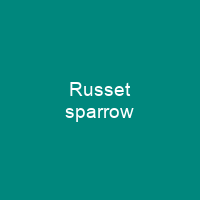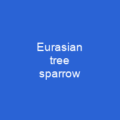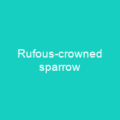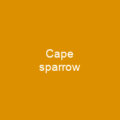The Russet Sparrow: A Unique Bird of Eastern Asia
Imagine a bird with warm rufous plumage, like the russet sparrow (Passer cinnamomeus). This fascinating passerine bird has captured the hearts of many nature enthusiasts and scientists alike. With its sweet musical chirps and unique habitat preferences, it’s no wonder why this species stands out among other sparrows.
Physical Characteristics
The russet sparrow is a medium-sized bird with a body length of 14-15 cm. Its plumage is warm rufous above and grey below, making it stand out in its environment. The bird has sexual dimorphism, meaning males and females look different from each other. Males have bright russet upperparts with black streaking, small black bibs, and pale grey underparts. Females, on the other hand, have mostly pale brown upperparts and pale grey underparts.
Interestingly, the russet sparrow’s vocalisations are described as “the sweetest and most musical” of any sparrow. Its basic call is a cheep or chilp, monosyllabic, softer than that of other sparrows. This unique voice adds to its charm and makes it a delightful bird to observe in the wild.
Habitat and Migration
The russet sparrow can be found in parts of eastern Asia and the Himalayas. It breeds from the far northeast of India through southeastern Tibet to Kashmir and Nuristan in Afghanistan. In eastern Asia, it is mostly migratory but also resident in some areas.
During autumn migration, which occurs between August and November, this bird prefers high altitudes. Its preference for these elevations is influenced by latitude: in the farthest south of its range, it never breeds below 2,500 meters above mean sea level, but in the northernmost part of its range, it often breeds by the sea.
In eastern Asia, the russet sparrow prefers light woodland. However, it is sometimes found in towns and agricultural areas. In Sakhalin, it breeds mostly in riparian forest, while in Hokkaidō, it finds a greater food supply for its young in more remote forests and has greater reproductive success.
Behavior and Diet
The russet sparrow’s behavior is similar to that of the house and Eurasian tree sparrows. It feeds on the ground but spends most of its time perching on branches. The bird prefers open, exposed branches for perching and is described as shy and wary by some observers.
Adult russet sparrows are mostly seed-eaters, eating seeds from herbs and weeds, rice, barley, and other grains. Berries are also eaten when available. Nestlings are fed mostly on insects, especially caterpillars and larval beetles obtained on trees and flying insects caught by aerial pursuit.
Nesting and Reproduction
The russet sparrow’s breeding season is short, lasting about three months. Its nests are dispersed uniformly rather than clustered, and they are most frequently built in tree cavities, often disused woodpecker nests. The male chooses the nest site for courtship display and builds the nest with both sexes.
Eggs are elongated ovals, whitish with a grey tinge and brown spots, weighing 19.2×14.2 millimetres. Both sexes incubate and feed young, with males often feeding more. The species is a minor pest of agriculture but also feeds its nestlings on insect pests.
Conservation and Cultural Significance
The russet sparrow has been featured in artworks by Japanese artist Hokusai and has appeared on postage stamps in Japan, The Gambia, and Guyana due to its depiction in his art. It is well-known in the Himalayas, with local vernacular names including lal gouriya in Hindi and kang-che-go-ma in Tibetan.
While not extensively studied for mortality rates, many young birds die from Isospora infections, to which the bird has little resistance. The russet sparrow breeds in various locations including black kite nests, eaves of roofs, stone walls, embankments, and disused swallow nests.

The russet sparrow, with its unique characteristics and cultural significance, continues to captivate the attention of birdwatchers and nature lovers. Its presence in various habitats across eastern Asia and the Himalayas serves as a reminder of the rich biodiversity that exists within our world.
You want to know more about Russet sparrow?
This page is based on the article Russet sparrow published in Wikipedia (retrieved on November 28, 2024) and was automatically summarized using artificial intelligence.







